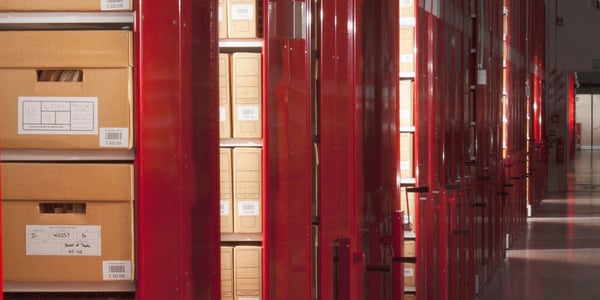
Off-site and remote storage facilities are not new. They were developed in the 1930s and continue to be important for preservation and long-term retention of materials. They provide a long-term solution for paper and microfilm records, sound and video recordings, and now data.
As paper collections expanded in the twentieth century, they filled the shelves, walls, and drawers of storage areas. Buildings bulged and overflowed with records and lesser used files relegated to closets, wet basements, or leaky and overheated attics. Every nook and cranny was filled, particularly in courthouses, but also in colleges and corporations. No empty room remained that way for long. The most common problem for cultural institutions, municipal offices, and courthouses continues to be lack of space.
Solutions
The ultimate solution was (and continues to be) off-site and remote storage, particularly for lesser used and older records. Collections and records were shifted to storage areas, garages and sheds, and, fortunately, a wide variety of depositories. Some of the depositories were staffed on a schedule; daily, weekly; or, sadly, monthly. The location of these older materials was first noted with signs that before a date, items were available upon request or in the depository. With the introduction of online databases and indices, records contained location information which was useful to researchers, customers, and staff.
Online indices and databases
Staff were responsible for intellectual and physical control of items, which meant inventorying older collections, locating older indices and record books, and identifying the format(s) of these items. As online indices and databases evolved, indices were scanned or transcribed into online databases. Digitized records and files were attached to each record. Researchers and staff could retrieve the older records without leaving the records or reading room. With open online access, researchers and customers could even work from home. Nevertheless, paper records are still requested—and safe, preservation appropriate storage is still imperative.
Accessing paper records
When it comes to courthouse and municipal records, staff and researchers need access to paper and sometimes online indices no matter the age of the materials. It is a matter of determining the location of the paper records. As courthouse records rooms filled, older records of historical and permanent value were moved to other locations throughout the building. Clerks and staff, and county archivists and records managers, needed to remember, map, or know where these older records were stashed. Every retirement meant the loss of historical memory. In some cases, finding these materials was, and continues to be, a treasure hunt through numerous rooms in attics and basements.
The introduction of online indices and databases for access to and management of courthouse and municipal records centers made locating the documents much easier. Location codes can be added to each record. Retrospective scanning and digitization projects improve access to these older records as images are linked to online indices. The older paper records are stored away, often off-site, and accessed only when digitized images are illegible or required for legal purposes.
The same is true of archival collections and records of historical and permanent value. These record series are retained and stored in repositories. Where once they might have been microfilmed for everyday use, today they are now digitized on demand and linked into finding aids that are accessible through online catalogs and databases.
Evolution of off-site and remote storage facilities
Commercial companies like University Microfilms International (UMI) and Iron Mountain are large scale, remote storage facilities that house, retrieve, and service collections.
- UMI, founded in 1938, built long-term storage facilities for retention of master microfilm with minimally fluctuating environmental conditions. Dissertations, Early English Books, and other microfilmed collections are housed at UMI and reprinted upon request. Today, UMI also hosts and manages digital copies of dissertations and theses, making paper copies upon request.
- Iron Mountain / National Underground Storage, established in 1951, uses old limestone caves to house valuable records, recordings, microfilm, government records and now electronic data for their clients.
- Ancestry.com and The Church of Jesus Christ of Latter-day Saints stores microfilm copies, genealogical records, and now DNA test results, in caves and old limestone mines in the Rocky Mountains.
- The National Archives and Records Administration of the United States (NARA) houses twentieth and twenty-first century military records, among others, in old limestone caves where the temperature and relative humidity are stable and records are secure.
Many libraries, archives, government agencies, and municipalities store their least used materials in commercial remote storage facilities.
Some organizations have built off-site storage facilities that are modeled on the Harvard Depository. The Harvard Depository system was developed in 1986 to meet preservation standards and long-term storage needs of the university. Infinitely expandable, the Harvard Depository model is used by universities, regional library systems, and even state systems. It’s the model for off-site and remote storage facilities to store lesser used and fragile items.
The Research Collections and Preservation Consortium (ReCAP), established in 2000, is the off-site storage facility in Princeton, NJ that houses and serves Columbia University, New York Public Library, and Princeton University. Using high-density storage and tight inventory control, they manage the daily shipment of materials to and from the three research institutions.
To maintain tight control over collections, the owning libraries, museums, archives, and records centers routinely catalog or inventory materials and change location codes to indicate storage or depository. Many of the items in storage have been microfilmed and now digitized as funding increased and costs decreased. Placing the digitized images in online catalogs means that the physical items stay in storage which protect them for future use.
In the past, when items were needed, they were pulled from storage and shipped back to the owning organization. Archivists and records managers supervised the use of the records and materials before returning the items to remote storage. Frequently requested materials are often returned to onsite shelves. It was common for archivists and records managers to arrange for photographic or micrographic duplication of requested items and then return the originals to the repository.
Today, many remote storage facilities are also home to master copies of microfilm, motion picture film, photographs, audio recordings and even art work. In some cases, when requests for stored materials are made, they are scanned or digitized at the remote site, sent to the requesting organization, and the master refiled. The owning organization then mounts the images on their online catalogs and databases. This minimizes repeat handling of fragile materials and takes advantage of the flexibility and versatility of online tools.
Summing it up
We must acknowledge that on-site facilities are full and our researchers are usually satisfied with digitized materials. Off-site and remote storage facilities have been around since the 1930s and continue to evolve as viable alternatives to on-site stacks and records rooms. They are a safe, affordable option to long-term retention of fragile, valuable, and essential materials.
If you want to read about remote storage facilities, check out:
- Harvard University, “The Harvard Depository: The Facility”
- Iron Mountain (National Storage Underground)
- Jessie Kratz, “The National Archives Goes Underground” Prologue Magazine 18 no. 1 (Spring 2016)
- “Mormon Genealogical Archives” Atlas Obscura
- Eugene B. Power, Edition of One: The Autobiography of Eugene B. Power Founder of University Microfilms (Ann Arbor, MI: University Microfilms Inc., 1990).
- Research Collections and Preservation Consortium (ReCAP)
- Kara Schechtman, “How a Book Warehouse is Changing Columbia’s Library” The Eye (March 8, 2018)


